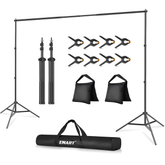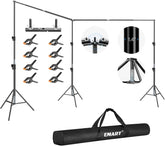Landscape Photography Tips
Landscape photography is a favorite with professional and amateur photographers alike.
There awaits a wealth of natural landscapes filled with beauty and drama, always changing with the seasons. To avoid taking bland images, follow these top landscape photography tips.
Create Depth

When you are taking a landscape photograph, try creating a sense of depth by keeping all the different elements of the image in focus.
To do this you need to use a small aperture, from f/16-f/22 because this keeps objects in the foreground and background sharp. Place your camera on a tripod (this will eliminate camera shake) when using a small aperture, as less light will be entering the lens.
Use a Wide-Angle Lens

Wide-angle lenses are preferred for landscape photography because they can show a broader view, and therefore give a sense of wide open space.
They also tend to give a greater depth of field and allow you to use faster shutter speeds because they allow more light. Taking an image at f/16 will make both the foreground and background sharp.
Remember to try some interesting angles with the photograph.
Use Photographic Filters

To get the best possible images, you can make use of two filters in your landscape photography.
Polarizing filters darken the sky and therefore bring out the blues in contrast to the white of the clouds.
Neutral Density (ND) filters prevent too much light from entering the camera. This is useful on bright days, when the camera is unable to give you a slow shutter speed (you may want to capture the movement of the sky or water for example).
Capture Movement

If you are working with moving water you can create a stunning white water effect by choosing a long exposure.
One way to do this is by using TV or S (Shutter-Priority) mode and choosing an exposure of 2 seconds or longer. You can also use AV (Aperture-Priority) mode and choose a small aperture like f/32 (which generally requires more light).
If working with bright daylight you must use an ND filter to reduce the amount of light hitting the camera, and this way the camera will allow you to have a longer shutter time.
You must always use a tripod for this kind of shot so that the rest of your image remains sharp.
Use Water as a Mirror

Water in subdued light can create beautiful effects and reflections.
The best time for this kind of shot is during the two “golden hours” which are the first hour after sunrise and the last hour before sunset. Put your camera on a tripod and set the mode dial to TV or S (Shutter-Priority) mode. Choose a slow shutter speed and allow the camera to choose the correct aperture.
If you struggle to get a sharp image you can push the ISO up although ISO 125 is a good starting point.
Take Account of People

A landscape isn’t just about nature; so why not include people?
A beautiful landscape can be complemented by a cute child or by a beautiful girl running or jumping through the flowers.
Remember the rule of thirds and place the person in an off-center position to create interest.
Choose a fast shutter speed if you want to freeze the action or a slower shutter speed if you want to capture movement.
Compose in Thirds

To use the rule of thirds, imagine four lines, two lying horizontally across the image and two vertical creating nine even squares.
Some images will look best with the focal point in the center square, but placing the subject off center at one of the intersecting points of the imaginary lines, will often create a more aesthetically composed photograph.
When a photograph is composed using the rule of thirds the eyes will wander the frame. A picture composed by the rule of thirds is usually more interesting and pleasing to the eye.






